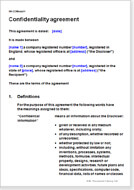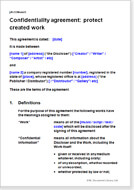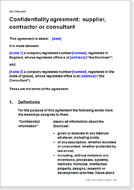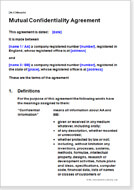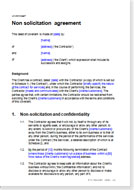Non-disclosure agreements
Our non-disclosure agreement templates help protect your sensitive information whenever you need to disclose it.
These templates are easy to edit, comprehensive in the coverage of law, and between them cover almost every circumstance. They can be put in place fast.
Use for any employee, new contractor, supplier, customer or sales agent. Use when selling your company, your book or your software. Use to bind both sides or just one side.
Confidentiality agreement
Use to explore the possibilities for a deal before signing an agreement.
It protects your secrets from being used by the other side if your proposed deal does not go ahead.
It is suitable for safeguarding any secrets, which may include personal information as well as commercial secrets.
Example uses:
- a proposed franchise
- a business acquisition
- the appointment of an agent or distributor
- demonstration of plans, ideas or a prototype
- discussions with a potential investor or lender
Confidentiality agreement: protect created work
This document is for use by a creator of a piece of work (whether a work of art, a book, a film, an idea, software code or other intellectual property) to prevent another party from using it without permission.
It allows the creator safely to explore development, manufacture, use or sale of his original work.
Examples of use:
- you are showing someone a work of art or a prototype design
- you are revealing a new process that will be valuable to the other party
- you are showing someone how something works (like showing the source code of software)
- you are looking for feedback on your ideas
- you wish to show someone an idea for a book, film or play
- you wish to show a manufacturer or developer your work
Confidentiality agreement: supplier, contractor or consultant
This version contains the same principles and strong protection as our other confidentiality agreements.
The words are changed only to suit a different application, namely for use with some person who may need access to your information in order to undertake work for you.
Use for any contractor who will have access to precious information from a software engineer to a business consultant to a parts supplier.
Mutual confidentiality agreement
This mutual confidentiality agreement contains the same structure and strong terms as our other agreements in this set, but it is drawn for both sides to sign and exchange.
Both sides agree to the same terms of disclosure, but not necessarily the disclosure of the same information.
Examples of use might be:
- You are considering the sale of all or part of a business. The other party needs to know details of the business, but you need to know about the financial strength of the buyer.
- You are discussing how to integrate products or processes together.
- You are considering a joint venture or partnership and each party needs to know whether the other parties can bring what they claim to be able to do.
- You are collaborating on a project and expertise and knowledge will be brought together (e.g. one party may have designs and the other may have unique production processes to realise the design).
Authorisation to release confidential information
This authorisation letter allows you to specify exactly who else is entitled to receive your confidential information other than the person with whom you have signed a confidentiality agreement.
Use it when it is necessary to permit access to colleagues of the prime signatory.
Non solicitation agreement
This is a comprehensive non-solicitation agreement between a contractor and his client, providing limitations on the extent to which the contractor may solicit the employer's clients or customers.
After the contracted work ends, the restraint is simply limited in time and geographical extent.
The document will be most useful to businesses where the contractor or employee has regular contact with clients or customers as well as confidential information about your business.
Use as a stand-alone document or cut and paste to an existing form of contract.
Choose whether you want an absolute restraint or a restraint only within a geographical area, such as England or Derbyshire. Additionally, you can limit the solicitation to time, for example: for six months, or two years, as you prefer.
Note: common law provides that a person’s freedom to trade is very important. Your terms must be reasonable. If the contractor were to challenge this document for any reason, the less strict the restraints the more likely it is that a Court would uphold them as reasonable.

If the document isn’t right for your circumstances for any reason, just tell us and we’ll refund you in full immediately.

We avoid legal terminology unless necessary. Plain English makes our documents easy to understand, easy to edit and more likely to be accepted.

You don’t need legal knowledge to use our documents. We explain what to edit and how in the guidance notes included at the end of the document.

Email us with questions about editing your document. Use our Lawyer Assist service if you’d like our legal team to check your document will do as you intend.

Our documents comply with the latest relevant law. Our lawyers regularly review how new law affects each document in our library.
What is a non-disclosure agreement?
A non-disclosure agreement (commonly referred to as an 'NDA' and interchangeably called a confidentiality agreement) is a legally binding contract between a disclosing party and a receiving party, which provides a safe environment for disclosing confidential information and that prevents further disclosure of such information to third parties.
A non-disclosure agreement enables you to divulge confidential information (such as business trade secrets) to the receiving party to use for a specifically defined purpose (known as the 'permitted purpose').
When should a confidentiality agreement be used?
The best way of keeping confidential material secret, is not to reveal it in the first place. Of course, there are many situations where you might want to disclose confidential information that is private, valuable or both.
Preventing unauthorised use of your confidential information
Much of the time, the party (whether a business or an individual) to whom you divulge will be in a situation to be able to benefit from the using the confidential information (perhaps in direct competition against you).
You can use a confidentiality agreement to prevent them from acting on the information, and thus to protect your personal or business information, ideas, and trade secrets.
Preventing unauthorised disclosure of your confidential information
A non-disclosure agreement can bind the party receiving your confidential information from the passing of it on to someone else.
Some common situations in which an NDA can be used include:
By an entrepreneur, before sharing valuable ideas for a new product or service with potential investors, manufacturers, licensees, or marketing companies.
When inducting new employees who will be in receipt of commercially sensitive information or information that could potentially be used to damage the business.
By companies that need to share valuable information with contractors or service providers. Such proprietary information could include trade secrets, manufacturing details, or customer details.
During negotiations for the sale or merger of business. The potential buyer will require valuable information, such as accounts and business plans, to be shared during the negotiations to assess the business. However, the information needs to be protected in case the sale or merger falls through.
By any person who wants to protect their creative work when sharing it to prevent it from being copied or distributed without their permission.
Which type of information can be protected using non-disclosure agreement?
The nature and subject of the confidential information is not as important as how it will be used. The information being protected can be something as basic as a bank account statement or as esoteric as a chemical formula.
Some examples of what constitutes confidential information include: trade secrets, product designs, databases, client information or lists, and patents, intellectual property ('IP'), and business know-how.
Signing of non-disclosure agreement reminds the other party that the information is sensitive, so he or she cannot later claim ignorance of its commercial value to you.
Which information is not considered to be confidential?
Despite that you had disclosed some information under a non-disclosure agreement with a party, the following information will not be considered confidential if it:
is already known to recieving party at the time of disclosure
is public information
is required to be disclosed persuant to a law or court order
came to be possessed by the recieving party from a third party that did not violate any contractual or legal obligations by disclosing the information.
Breaches of confidentiality agreement
A breach of a non-disclosure agreement can occur if a party bound does not meet their obligations under the contract (for example, passing on your trade secrets or financial information).
However, it is often difficult to prove a breach. Therefore, it is really important that your agreement clearly defines the parties bound, the confidential information that is to be protected, restrictions on use of confidential information, and exception to the restrictions (terms already covered in documents).
What happens when a confidentiality agreement is breached?
Your non-disclosure agreement can specify the remedies to be followed in the event of a breach. One remedy could be an agreed monetary value to be paid in damages to the wronged party. However, in some cases it can be difficult to determine the correct value of the ownership and privacy of confidential information.
While, proving breaches can be difficult, you should not make the mistake of thinking that breaking a confidentiality agreement will be fairly inconsequential. A wronged party can be entitled to percentage of profits that have resulted from misuse of information, damages, and even an injunction.
Remedies even if there is no financial loss
Even if there is no financial loss to the wronged party, the court can award damages on 'Wrotham Park' basis. In this case, the amount awarded was the value that the wronged party might have successfully bargained for in return for accepting the breach.
In a similar case, Verceo and Others v. Rutland Fund Management Ltd. (2010), Vercoe had shared confidential information under a non-disclosure agreement about a potential acquisition target company with Rutland.
When Rutland breached the agreement by acquiring the target and made a heafty profit, Vercoe was able to argue that it was entitled to resultant profits, rather than a smaller sum in damages. Vercoe was awarded damages based on the value for which they would have allowed Rutland to exit the non-disclosure agreement.
Our confidentiality agreement templates
We have drawn the documents to cover virtually all situations and broadly cover all information passing to the other party, but in a way that enables you to insert your own precise secrets if you want to specify them. Using our template, you can create your own non-disclosure agreement.
A non-disclosure agreement can be of two types but the terms that are used are more or less the same. A unilateral non-disclosure agreement is designed to protect information given by one party to another. If information is shared in more than one direction then a mutual non-disclosure agreement is used.
Confidentiality agreement (single party)
This document allows you to pass on confidential information where the receiver is a single party. Examples when you might use this non-disclosure agreement include: a proposed franchise, a business acquisition, the appointment of an agent or distributor, demonstration of plans, ideas, or a prototype.
Mutual confidentiality agreement
This non-disclosure agreement enables you to explore the possibilities for a deal before signing an agreement that covers the terms. It binds both parties to the same terms of disclosure, but not necessarily the same information. Examples of use might be: sub-contract manufacture, business acquisition, or joint product development.
Confidentiality agreement: supplier, contractor, or consultant
This non-disclosure agreement is specifically draw where a supplier, contractor, or a consultant may find out commercially sensitive information concerning your business in the course of providing goods or services.
It prevents only one party - the supplier, contractor or consultant - from disclosing information received in the course of providing goods or services.
Using this non-disclosure agreement is an excellent way to remind the supplier of their responsibilities to maintain client confidentiality.
Confidentiality agreement: protect created work
This non-disclosure agreement is specifically drawn to be used by a creator of any work (such as art, a book, film, idea, software code, or other IP) to prevent another party from using the ideas within the work of the creator without their permission.
This non-disclosure agreement provides a superb framework to allow the creator to explore development, manufacture, use or sale of the piece of work together with the other party.
Terms included in our confidentiality agreement templates
First and foremost, we provide a very wide definition of confidential information so that you can easily edit it to cover your precise requirements.
These documents give you choices as to how you want the recipient of your information to deal with it. You may limit disclosure to the person who signs this agreement or you may allow him to pass the information to other professional advisers or employees or consultants.
All our NDA templates:
- can be used when either or both parties are individuals or businesses
- are fast to put in place: our guidance notes make completion easy
- provide strong legal protection
- can be used to protect defined information, or generally
- are suitable for any sort of confidential information
- cover the security of disclosed information: how information must be kept and stored
- comply with the requirements of the Data Protection Act 1988
Non-circumvention
A non-circumvention clause prevents the recipient of confidential information from bypassing ('circumventing') the disclosing party and approaching the disclosing party's suppliers or customers with a view to obtaining the same parts or products or selling in competition. Non-circumvention clauses are intended to prevent the recipient from harming the disclosing party's business.
No poaching
Similar to a non-circumvention clause, a no poaching clause prevents the recipient from approaching employees or staff with the intention of employing them in competition. Poaching is an issue that can cause irreparable harm to the discloser, as not only does the employee have knowledge of the business activities of the disclosing party, but also the discloser loses the skills of its employee for future development.
Managing confidentiality and non-disclosure after an agreement is in place
You should recognise that all the legal agreements in the world cannot prevent accidental or unintentional disclosure (for example, careless talk over a drink with a friend, or when leaving your documents out for public rubbish collection).
You can manage risks by limiting the information that you disclose, and the people who know about it. Both these things are covered by our documents. We all tend to be diffident about asking for a confidentiality agreement from people we 'trust' with their ideas, but who have no obligation to keep our secrets safe, (for example, friends, potential investors, partners and customers). This is a great mistake. The upside of protection from insisting on an agreement, however awkward, far outweighs the downside of loss of private data.
Once enough information has been exchanged for terms of a deal to be agreed, another Net Lawman document (for example, a business sale agreement) will record the details and continue the requirement for confidentiality for as long as necessary.
Either party can initiate use of a non-disclosure agreement. If you are the receiver of information, you can make the other side at ease by suggesting the use of one before they do.
Remember to be sure that an agreement is dated and signed before information is disclosed.
It was quicker to buy the agreement than write it and saved £'s on Solicitor costs.
All rights reserved

